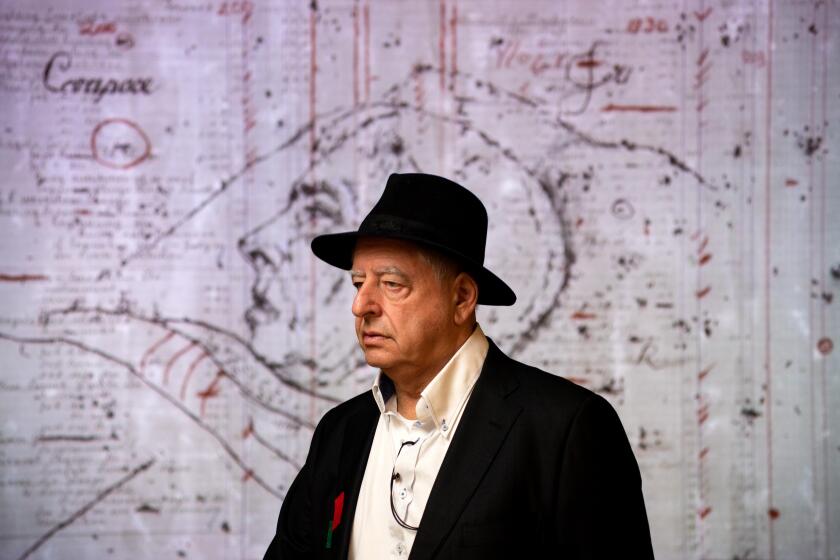Review: William Kentridge’s sprawling Broad installation is an extraordinary meditation on apartheid
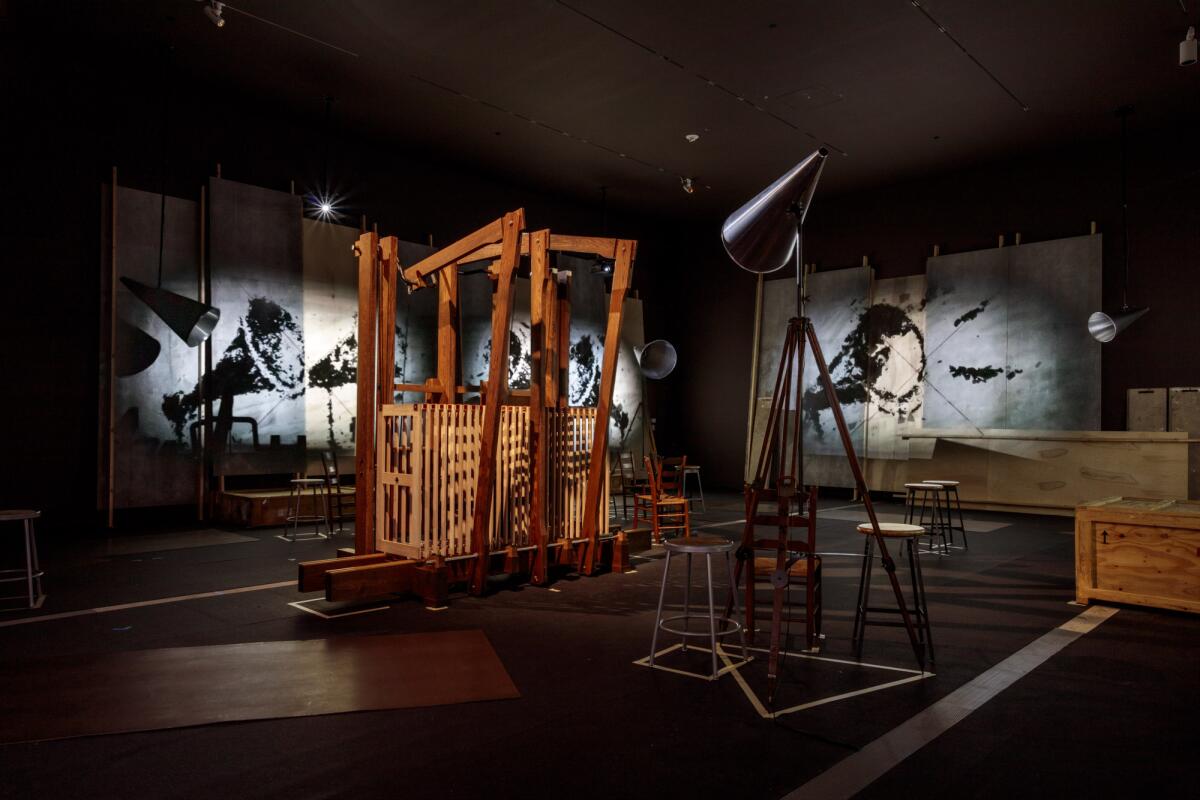
- Share via
The extraordinary survey exhibition of South African artist William Kentridge currently at the Broad comes at an auspicious moment. With the entrenched structural legacies of European colonialism emerging into sharper focus in many parts of the globe — including the United States — while authoritarian political systems burrow in, his charged and eloquent drawings, films, installations, sculptures and prints speak to the physical cruelties and emotional disturbances, past and present, of his home country’s apartheid regime.
That regime is over, but its damage is not easily repaired. What takes generations to establish takes generations to dismantle.
The crescendo comes in “The Refusal of Time” (2012), a chaotic, five-channel video installation punctuated with noise booming from steel megaphones amid the rhythmic, chugging clatter of a big, motorized sculpture assembled from sturdy wood beams and a metal frame. The sculptural contraption, nicknamed “the elephant,” is described in notes as a breathing machine — a kind of mechanical bellows crossed with an iron lung and an industrial loom.
The brilliant “elephant,” lumbering and impressive like its African namesake, is an infernal machine. An abstract weaving loom, it evokes the textile industry that pushed the first Industrial Revolution into overdrive, accelerating the slave trade of settler colonialism. That it also provides an intimation of forced breath within an injured body is unmistakable.
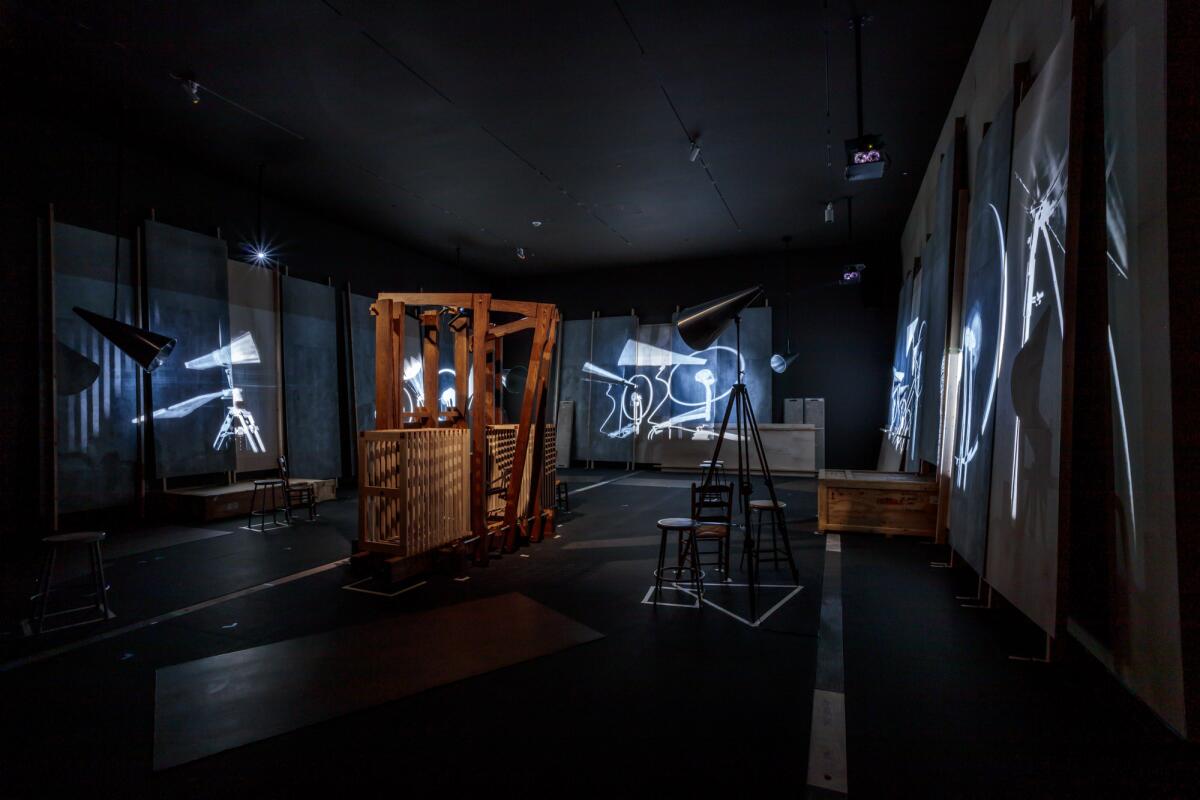
Shipping crates are piled around the darkened room, which is ringed with wall-size video projections providing a flickering light. Dancers swirl, the artist repeatedly climbs over chairs like a man going nowhere and a group of Man Ray-style metronomes slowly goes out of synchronization. Other repetitions unfold, both discreet and raucous. The time being refused is an orderly, businesslike conception of progress.
You’re in the belly of a beast. Scattered stools let you sit and watch while pondering the dissolution all around. Slowly, steadily, the poignant beauty of the installation underscores the redemptive power of consciousness, while a sense of helplessness is transformed into a spur.
The exhibition, “William Kentridge: In Praise of Shadows,” is large — around 180 individual objects made over the last 30 years — and a good number, including “The Refusal of Time,” come from the Broad’s own collection.
An elaborate installation by Belgian designer Sabine Theunissen, who has worked with the artist before, incorporates five large immersive works in a variety of thematic spaces, including an old-fashioned rural theater, a sketch of a civic opera house and a bare institutional classroom. A gallery near the end evokes the artist’s Johannesburg studio. Ed Schad, the museum’s curator, has used the opportunity to provide helpful context and illuminating elaboration for a major work in the permanent collection. The catalog is excellent.
Almost all the works in the show, including many of the projections, are black-and-white. Kentridge, whose first artistic immersion came in collaborative theater projects — which he still pursues today — began gaining international attention as an artist in 1992, with shows of films and drawings at the Venice Biennale and New York’s Museum of Modern Art. Many of his films are animations made from gritty charcoal drawings on ordinary sheets of paper, rather than slick, colorful, multiple cels of transparent plastic. The laborious process has effects both visual and conceptual.
A single charcoal drawing is worked, reworked, erased and altered, with every change photographed as a frame of film. Visually, the darkly personal images are enervated, at once tactile and jumpy. The erasures are relentless, and so is the reinvention. Conceptually, the palpable flow of tenacious drawing and erasing and drawing again creates a narrative of creation, loss and persistent renewal. Even when the imagery might be grim, showing ravaged lands or monstrous men, hope glimmers.
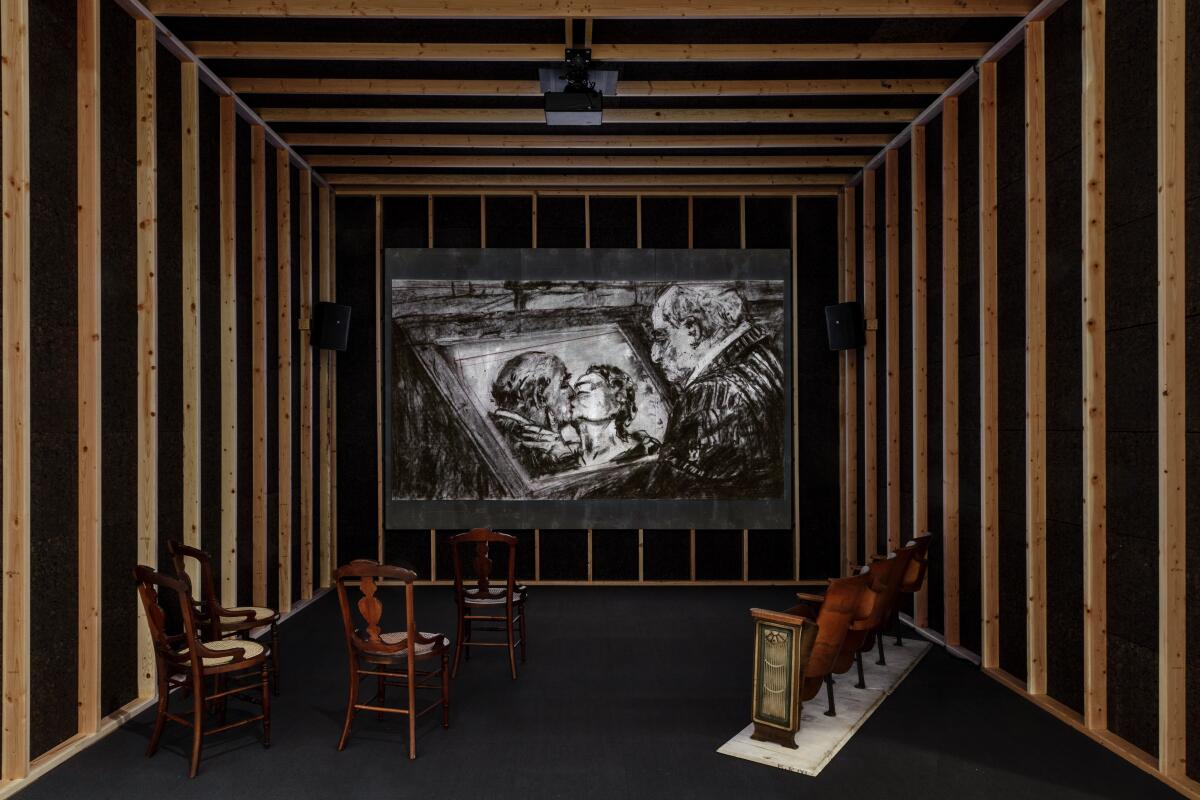
Black-and-white removes the animations from the more commonplace commercial realm of popular cartoons, which tend toward vibrant color. (A film’s final drawing is sometimes independently exhibited.) The shadows cited in the exhibition’s title reveal as much as they conceal, and the drawings’ animated blackness heightens a sense of disclosure.
“Muizenberg 1933,” three inky, 1975 lino-cut prints near the entry, show how early Kentridge began to work toward animation. A ridiculous man wearing an incongruous Homburg and suit sits in a beach chair at a popular surfing spot. One linoleum plate was cut and printed; two more figures were gouged into the plate, which was printed again; finally, still another figure was added, and the plate was printed a third time.
In the lino-cut process, material removal from the plate paradoxically adds to the visual image when it is printed. A negative becomes a positive. 1933 was the year of South Africa’s first national election following legal revisions that increased white voting power. In 1975, when politically induced apartheid trauma was rife, Kentridge found an absurdist and contradictory artistic path to illuminate historical precedent.
“Ubu Tells the Truth” is a suite of eight etchings related to a 1997 Kentridge film. It’s a story of ruthlessness in which scenes based on Alfred Jarry’s 1896 proto-Dada play, “Ubu Roi,” about a grotesque midlevel bureaucrat who murders the Polish king to grab the throne, are told out of sequence.
The artist discusses ‘William Kentridge: In Praise of Shadows,’ on view at the Broad museum in downtown Los Angeles through April 9, 2023.
An already cracked story collapses into itself. Made two years after South Africa’s Truth and Reconciliation Commission was set up under the auspices of Archbishop Desmond Tutu to address apartheid injuries, the tale’s satirical incoherence around authoritarian power is piercing.
Nearby, a mechanized sculpture composed of three ordinary Singer sewing machines dances like a Rockettes chorus line, with traditional African music “singing” from attached megaphones. The jerky machines pivot back and forth, the music of invisible workers a soothing balm.
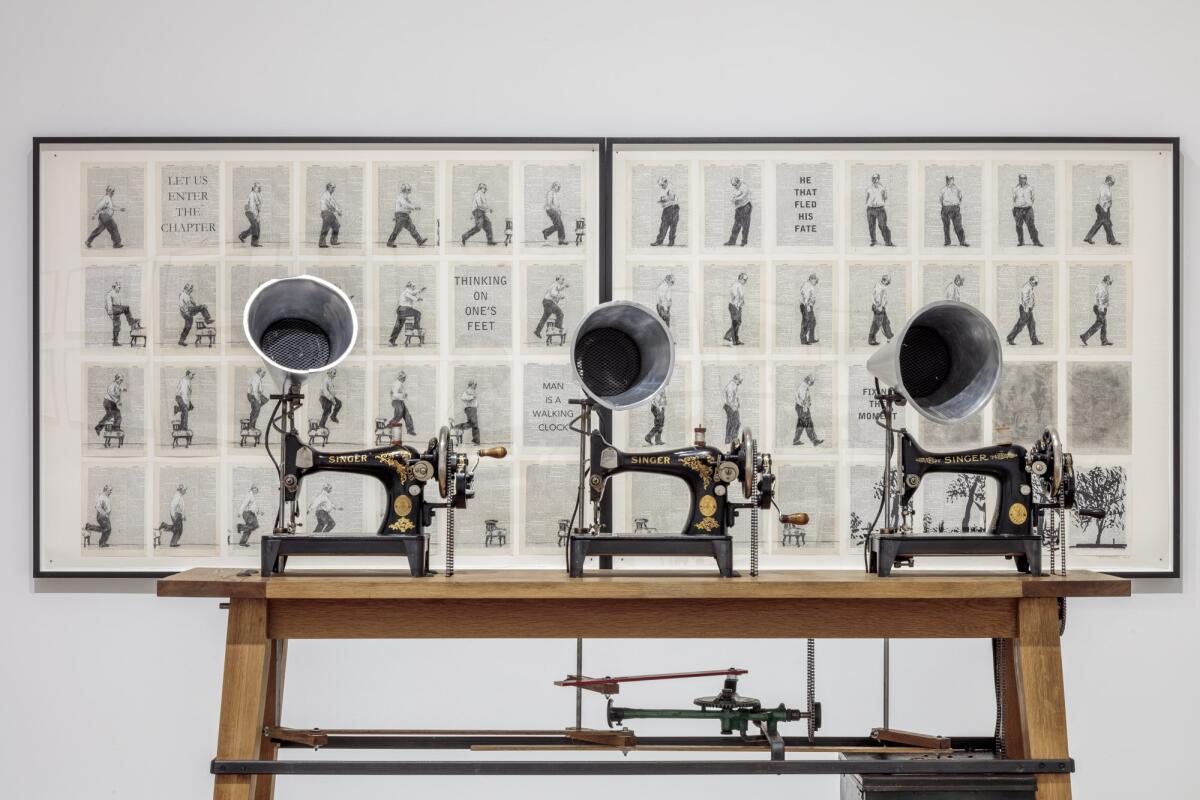
In the next room, a stand-in for the artist appears in an early film. He’s perusing art inside a museum, a scene that alternates with vernacular images of daily life — couples kissing, workers in a mine, decaying fruit, a funeral and more. They’re subjects a genre painter might choose. Finally, back inside the museum, a tomb gets dug into the floor, causing the grand cultural edifice to fall into itself.
Contradictions abound. Drawings of armored military transport vehicles common on the streets of 1980s South Africa signal comforting power if you’re white, terror if you’re Black. Turning Georges Méliès’ famous 1902 science fiction short, “A Trip to the Moon,” into an equally fanciful vision of dreams dashed, a filmed journey set aboard a coffeepot-spaceship runs in reverse.
Goya working amid the decay and corruption of the Spanish crown, Russian revolutionary artists Vladimir Tatlin and Gustav Klutsis sweeping away Czarist crimes and Max Beckmann navigating the mounting horrors of Nazi Germany leap to mind at different moments in the show. Kentridge, born to a Lithuanian immigrant family of anti-apartheid lawyers in 1955, makes inventive art in a heady — and essential — tradition. He pretty much holds his own.
In light of his work’s pressing topicality, the show’s one disappointment is how few visitors were there on the day I saw it. During two absorbing hours, no more than a dozen people came through. Up the escalator, the Broad’s permanent collection rooms were busy.
Presumably the difference is explained by the $18 adult-admission fee for the Kentridge show, while upstairs is free. Kentridge is not a popular name, like the freebie third floor’s Warhol and Koons; but many an unsuspecting visitor who just wandered in would surely be captivated by his work.
Why an exhibition at a museum founded by one of California’s wealthiest families might need any entry fee is not clear. I can’t imagine that the roughly $200 in income earned during my time there really matters for institutional stability. But surely it doesn’t matter as much as making Kentridge’s grave and urgent art as widely accessible as possible.
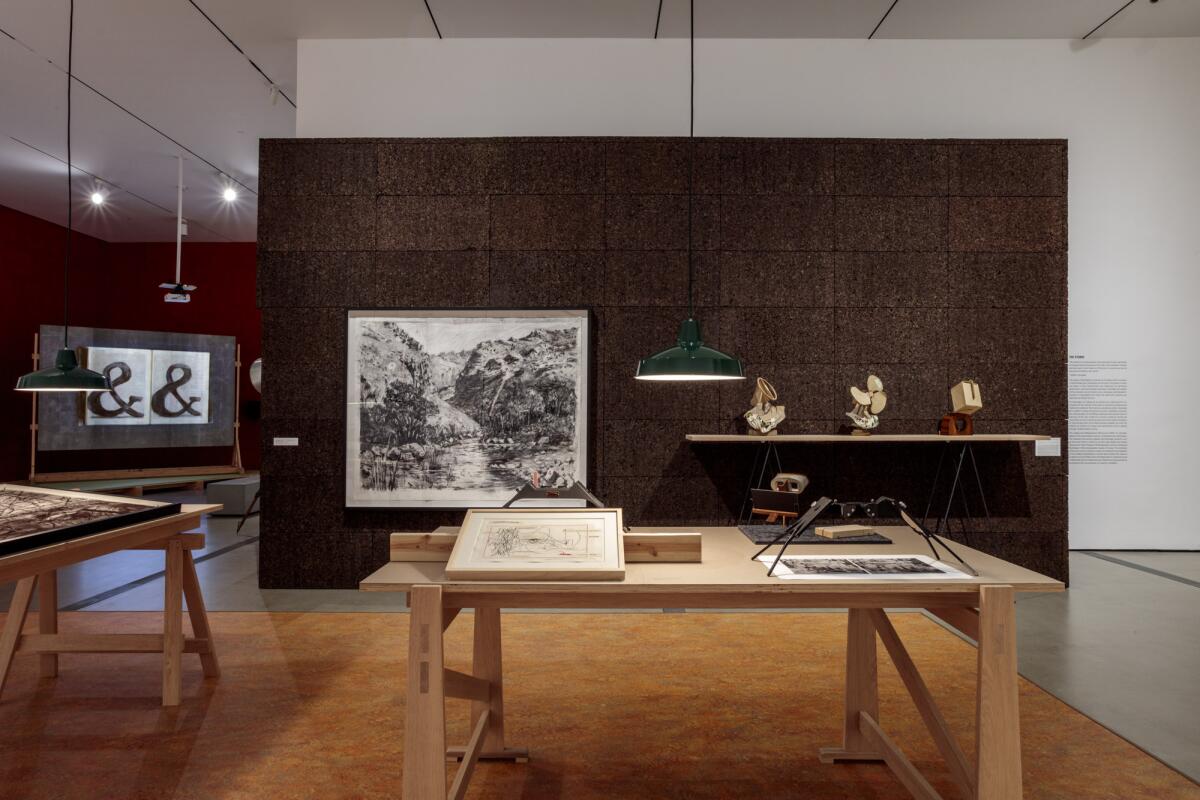
'William Kentridge: In Praise of Shadows'
Where: The Broad, 221 S Grand Ave., Los Angeles
When: 11 a.m. to 5 p.m. Tuesday, Wednesday and Friday, 11 a.m. to 8 p.m. Thursday, 10 a.m. to 6 p.m. Saturday and Sunday. Closed Monday and Christmas. Through April 9.
Price: $18 for adults, $12 for students (with valid student ID), free for children 17 and under.
Info: (213) 232-6200, thebroad.org
More to Read
The biggest entertainment stories
Get our big stories about Hollywood, film, television, music, arts, culture and more right in your inbox as soon as they publish.
You may occasionally receive promotional content from the Los Angeles Times.
